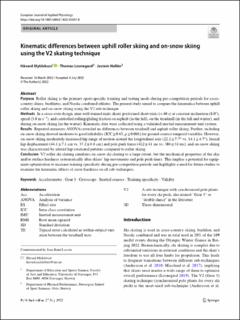| dc.contributor.author | Myklebust, Håvard | |
| dc.contributor.author | Losnegard, Thomas Johansen | |
| dc.contributor.author | Hallén, Jostein | |
| dc.date.accessioned | 2023-01-06T07:27:46Z | |
| dc.date.available | 2023-01-06T07:27:46Z | |
| dc.date.created | 2022-09-23T09:46:09Z | |
| dc.date.issued | 2022 | |
| dc.identifier.citation | Myklebust, H., Losnegard, T., & Hallén, J. (2022). Kinematic differences between uphill roller skiing and on-snow skiing using the V2 skating technique. European Journal of Applied Physiology, 122(11), 2355-2365. | en_US |
| dc.identifier.issn | 1439-6319 | |
| dc.identifier.uri | https://hdl.handle.net/11250/3041397 | |
| dc.description.abstract | Purpose: Roller skiing is the primary sport-specific training and testing mode during pre-competition periods for cross-country skiers, biathletes, and Nordic combined athletes. The present study aimed to compare the kinematics between uphill roller skiing and on-snow skiing using the V2 sub-technique. Methods: In a cross-over design, nine well-trained male skiers performed short trials (< 40 s) at constant inclination (8.0°), speed (3.0 m‧s−1), and controlled rolling/gliding friction on asphalt (in the fall), on the treadmill (in the fall and winter), and during on-snow skiing (in the winter). Kinematic data were collected using a validated inertial measurement unit system. Results: Repeated-measures ANOVAs revealed no differences between treadmill and asphalt roller skiing. Further, including on-snow skiing showed moderate to good reliability (ICC ≥ 0.63, p ≤ 0.001) for ground-contact temporal variables. However, on-snow skiing moderately increased hip range of motion around the longitudinal axis (22.2 ± 7.7° vs. 14.1 ± 4.7°), lateral hip displacement (44.1 ± 7.1 cm vs. 37.2 ± 6.6 cm) and pole push times (422 ± 41 ms vs. 386 ± 31 ms), and on-snow skiing was characterized by altered hip rotational patterns compared to roller skiing. Conclusion: V2 roller ski skating simulates on-snow ski skating to a large extent, but the mechanical properties of the skis and/or surface hardness systematically alter skiers’ hip movements and pole push times. This implies a potential for equipment optimization to increase training specificity during pre-competition periods and highlights a need for future studies to examine the kinematic effects of snow hardness on all sub-techniques. | en_US |
| dc.description.abstract | Kinematic differences between uphill roller skiing and on-snow skiing using the V2 skating technique | en_US |
| dc.language.iso | eng | en_US |
| dc.publisher | Springer Link | en_US |
| dc.rights | Navngivelse 4.0 Internasjonal | * |
| dc.rights.uri | http://creativecommons.org/licenses/by/4.0/deed.no | * |
| dc.title | Kinematic differences between uphill roller skiing and on-snow skiing using the V2 skating technique | en_US |
| dc.title.alternative | Kinematic differences between uphill roller skiing and on-snow skiing using the V2 skating technique | en_US |
| dc.type | Peer reviewed | en_US |
| dc.type | Journal article | en_US |
| dc.description.version | publishedVersion | en_US |
| dc.rights.holder | The author | en_US |
| dc.subject.nsi | VDP::Samfunnsvitenskap: 200 | en_US |
| dc.source.journal | European Journal of Applied Physiology | en_US |
| dc.identifier.doi | 10.1007/s00421-022-05007-0 | |
| dc.identifier.cristin | 2054640 | |
| cristin.ispublished | true | |
| cristin.fulltext | original | |
| cristin.qualitycode | 1 | |

